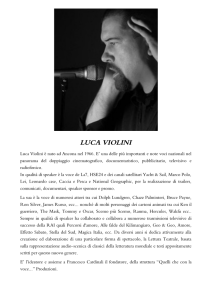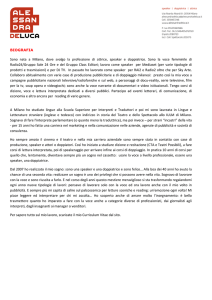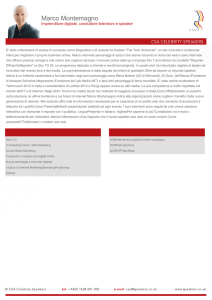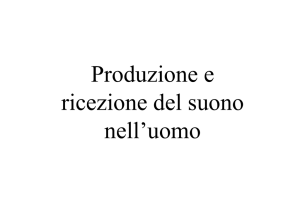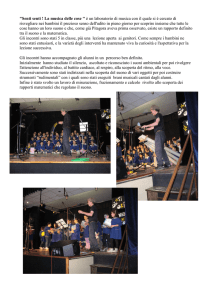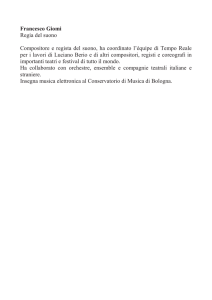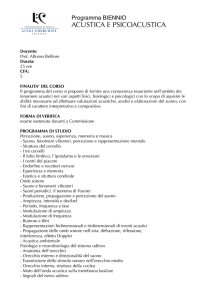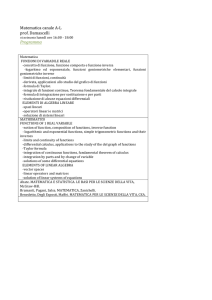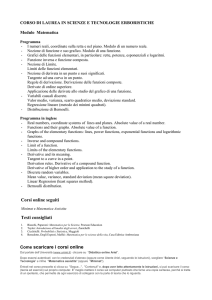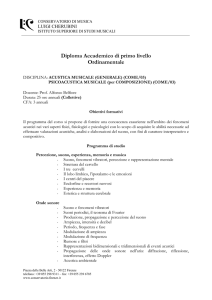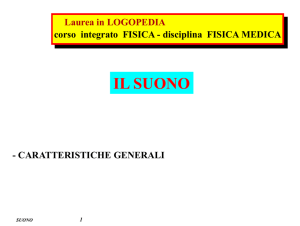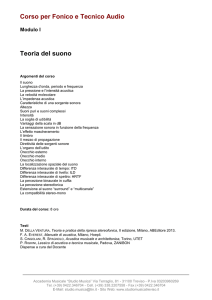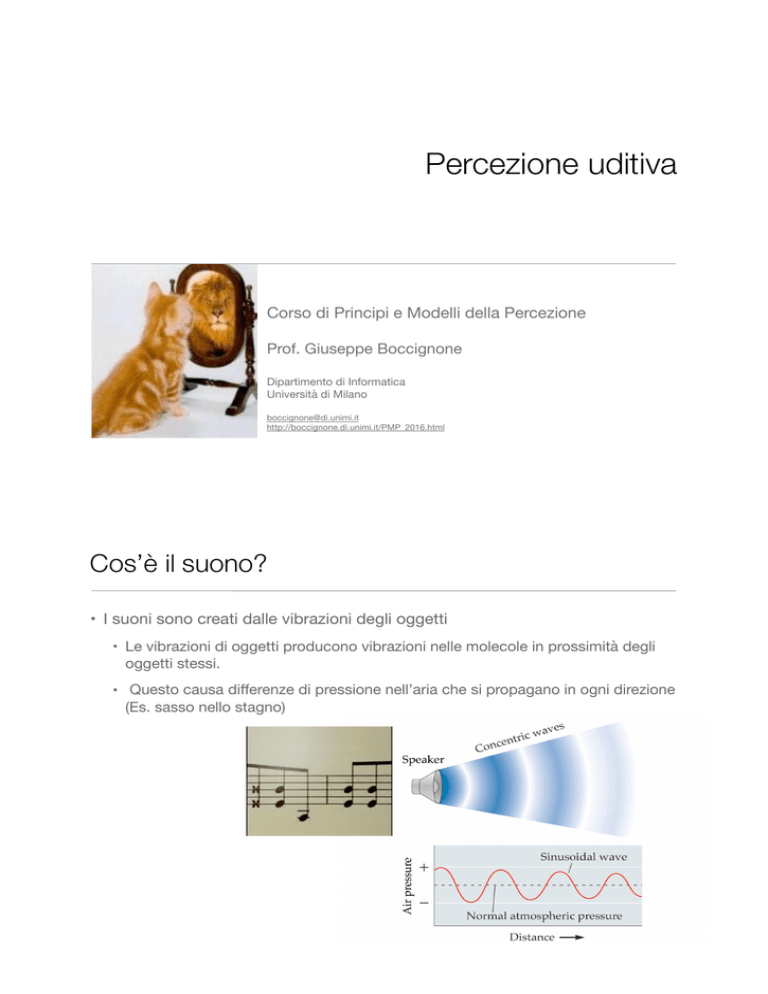
Percezione uditiva
Corso di Principi e Modelli della Percezione
Prof. Giuseppe Boccignone
Dipartimento di Informatica
Università di Milano
[email protected]
http://boccignone.di.unimi.it/PMP_2016.html
Cos’è il suono?
• I suoni sono creati dalle vibrazioni degli oggetti
• Le vibrazioni di oggetti producono vibrazioni nelle molecole in prossimità degli
oggetti stessi.
• Questo causa differenze di pressione nell’aria che si propagano in ogni direzione
(Es. sasso nello stagno)
Cos’è il suono?
• Le onde sonore viaggiano con una certa velocità di propagazione
• Questa dipende dal mezzo di trasmissione. • Esempio: La velocità del suono attraverso l’aria è di circa 340 metri al secondo,
ma nell’acqua essa cresce sino a 1500 metri al secondo
Velocita’
340 m/sec
1200 km/ora
Cos’è il suono?
• Caratteristiche fisiche delle onde sonore
– Ampiezza: Grandezza del profilo di variazione di pressione dell’onda sonora
– Intensità: Quantità di energia di un suono che cade su una unità di area
– Frequenza: Per i suoni è il numero di cicli (in termini di variazione di pressione)
che si ripetono in un secondo
• Caratteristiche psicologiche delle onde sonore
– Volume (loudness): L’aspetto psicologico del suono correlato alla intensità
percepita
– Altezza (pitch): L’aspetto psicologico del suono correlato alla frequenza
percepita
Caratteristiche del suono
dipende da un insieme
di proprietà spettrali
(armoniche, ecc)
Livello
psicologico
Livello fisico
Pitch
Frequenza
Cos’è il suono?
//Ampiezza e frequenza
dipende da frequenza,
rumore, ambiente acustico
Loudness
Ampiezza / Intensità
Cos’è il suono?
//Ampiezza e frequenza
• L’udito degli umani è sensibile ad un ampio range di intensità
• Il rapporto fra il volume più basso e quello più alto di un suono che risulta percepibile
è quasi di uno su un milione
• Al fine di descrivere differenze in ampiezza, i livelli del suono sono misurati su una
scala logaritmica le cui unità sono i decibels (dB)
• Cambiamenti relativamente piccoli in decibel possono corrispondere a cambiamenti
fisici molto consistenti (un incremento di 6 decibel corrisponde circa ad un raddoppio
della pressione del suono)
dB = 20 log(p/po)
per p = po, dB = 0
Cos’è il suono?
//Ampiezza e frequenza
• La frequenza è associata con l’altezza (pitch) di un suono
• Suoni a basse frequenze corrispondono a suoni “bassi” (e.g., i suonati da una
tuba)
• Suoni ad alta frequenze corrispondono a suoni “acuti” (e.g., i suonati da un
clarino)
Cos’è il suono?
//Ampiezza e frequenza
• La frequenza è associata con l’altezza
di un suono
• L’udito degli umani è sensibile ad un
ampio range di frequenze: da circa
20 a 20,000 Hz
Cos’è il suono?
//Ampiezza e frequenza: rumori ambientali
Cos’è il suono?
//Sinusoidi e toni puri
• Uno dei più semplici tipi di suoni: onde sinusoidali = toni puri
• Onde sinusoidali: Onde per cui le variazioni in funzione del tempo sono descritte
da un’ onda sinusoidale
• Il tempo per un ciclo completo dell’onda sinusoidale è definito periodo
• Ci sono 360 gradi di fase in un intero periodo
Diapason
Cos’è il suono?
//Sinusoidi e toni puri
Cos’è il suono?
//Sinusoidi e toni puri
Periodo:
Equazione di un'onda progressiva :
Numero d'onda:
Equazione di un'onda retrograda :
Pulsazione:
Frequenza:
Velocità:
Trigonometric functions and sound
Cos’è il suono?
The sounds we hear are caused by vibrations that send pressure waves through the air. Our ears
respond to these pressure waves and signal the brain about their amplitude and frequency, and the
brain interprets those signals as sound. In this paper, we focus on how sound is generated and imagine
generating sounds using a computer with
a speaker.
Sound
Waves
//Funzioni trigonometriche e suono
Once cycle of sin(2π t)
sin(2 π t)
1
• Loud
Una “cassa”
è speakers
fatta diproduce sound by
Frequency of oscillation
– The diaphragm of the speaker moves out, pushing air molecules
una
componente
vibrando
together che
We need- to
describe
oscillations
thatvibra
occure many
0.5
–
The
diaphragm
also
moves
in,
pulling
genera
onde
di
pressione
times per second. The graph of a sine function
thatthe air molecules apart
The cycle of this process creates alternating high- and low-pressure
- through
un elettromagnete
genera
oscillates
one– cycle
ache
second
looks
like:
regionsin
that
travel
through
the air
0
l’oscillazione
−0.5
A function that oscillates 440 times per second will
look more like this. Note that the time axis only runs
to 1/20 of a second.
−1
0
0.2
0.4
0.6
Time t in seconds
0.8
1
Once cycle of sin(2π 440 t)
1
We say that the oscillation is 440 Hertz, or 440 cycles
per second.
sin(2 π 440 t)
0.5
Inviando una corrente elettrica variabile
all’elettromagnete, questo fa oscillare la
Generating
sound with a computer speaker
“membrana”
0
A speaker usually consists of a paper cone attached to
−0.5
an electromagnet.
By
sending
an
oscillating
electric
Se l’oscillazione è di 440 cicli per
current through the electromagnet, the paper cone can
−1
secondo (Hz), viene generata la nota LA
0
0.01
0.02
0.03
0.04
0.05
be made to oscillate back and forth. If you make a
Time t in seconds
speaker cone oscillate 440 times per second, it will
sound like a pure A note. Click here to listen. If you make a speaker cone oscillate 880 times per
second, it will sound like an A, but one octave higher. Click here to listen. We’ll call this A2. On a
sin(2 π 440 t)
0.5
Cos’è il suono?
0
Speaker location
//Funzioni trigonometriche e suono
ith a computer
speaker
nsists of a paper cone attached to
−0.5
sending an oscillating electric
ectromagnet, the paper cone can
−1
0
0.01
0.02
0
ack and forth. If you make a
Time t in seco
Se l’oscillazione è di
440 times
per second, it will
880 Hz viene
generata
la nota
LAlisten. If you make a speaker cone oscillate 8
ote. Click
here
to
ma di un’ottava
superiore
ike an A,
but(LA2)
one octave higher. Click here to listen. We’ll cal
1760 Hz
ottengo
raphs ofA the
location
of the speaker cone as a function of time, e
LA3
Raising the frequency to 1760 Hertz raises the pitch another o
de of oscillation, that is, how high and how low the graph goes,
d the speaker cone goes, changes the volume of the sound. The
he amplitude of an oscillation of 1760 Hertz rising from 0 to 1.
Cos’è il suono?
g volume A3 four times.
A (440 Hz)
4
2
0
−2
−4
0
0.005
0.01
0.015
0.02
0.025
0.03
0.035 0.04 0.045
Time (seconds)
0.05
0.03
0.035
A (880 Hz)
4
2
0
−2
−4
0
0.005
0.01
0.015
0.02
0.025
0.04
0.045
0.05
0.04
0.045
0.05
0.04
0.045
0.05
A (1760 Hz) getting louder
0.1
0
−0.1
0
0.005
0.01
0.015
0.02
0.025
0.03
0.035
A−C#−E chord (440, 554, 659 Hz)
4
2
0
−2
−4
0
0.005
0.01
0.015
0.02
0.025
0.03
0.035
A−C#−E−A2 chord (440, 554, 659, 880 Hz)
5
//Funzioni trigonometriche
e suono
0
or scalesEsempio: scala cromatica
la frequenza di oscillazione
per
ncreasesAumenta
the frequency
of oscillation
by 12 steps from one octav
passi di 1/12
frequencies of the chromatic scale would be
−5
0
0.005
1
12
0.01
0.015
2
12
0.02
0.025
0.03
0.035
12
12
0.04
0.045
0.05
440 ⋅ 2 0 ,440 ⋅ 2 ,440 ⋅ 2 ,K 440 ⋅ 2 = 880
etween hasLAa name of
its own;
they
are: A, A#, B, C, C#, D, D#
LA#
SI
DO, DO#,RE,RE#,MI,FA,FA#,SOL,SOL# LA2
le starts at 440 Hertz, then increases over 8 steps to A2, along th
D (5/12), E (7/12), F# (9/12), G# (11/12) and A2 (12/12). A grap
n an A-major scale can be found on a later page. Click here to l
Cos’è il suono?
//Funzioni trigonometriche e suono
Speaker position
A−major scale
A 440 Hz
1
B 493.88 Hz
0.5
0
−0.5
−1
0
0.02
0.04
0.06
0.08
0.1
Time
C# 554.37 Hz
1
0.12
0.14
0.16
0.18
0.2
0.36
0.38
0.4
0.54
0.56
0.58
0.6
0.74
0.76
0.78
0.8
D 587.33 Hz
0.5
0
−0.5
−1
0.2
0.22
0.24
0.26
0.28
0.3
E 659.26 Hz
1
0.32
0.34
F# 739.99 Hz
0.5
0
−0.5
−1
0.4
1
0.42
0.44
0.46
0.48
0.5
G# 830.61 Hz
0.52
A 880 Hz
0.5
0
−0.5
−1
0.62
0.64
0.66
0.68
0.7
0.72
Cos’è il suono?
e sounds
sovrapposizione di suoni
Chords and//accordi
superposition of
A chord is formed by playing multiple notes at once. You could play a chord with three notes by
accordo
è ottenuto
suonando
putting threeUn
speakers
side
by side and
making più
each oscillate at the right frequency for a different note.
note
contemporaneamente
Or, you can add together the functions for each frequency to make a more complicated oscillatory
function and make your speaker cone oscillate according to that function. For example, if you want to
Esempio:
accordo
di LA
maggiore
play an A – C#
- E chord,
you can
separately
make three speakers oscillate according to the functions:
sin( 440 ⋅ 2πt ),
4
sin( 440 ⋅ 2 12 ⋅ 2πt ),
7
sin( 440 ⋅ 2 12 ⋅ 2πt )
If you want one note louder or softer than the others, you can multiply the whole function by a constant
LA of that note. Each
DO# speaker will make
MI pressure waves in the air, and
to increase or decrease the volume
these pressure waves from different speakers will overlap as they move toward your ear. By the time
they are at your ear, you will be unable to tell which speaker they came from; the pressure waves will
have been superimposed on one another, or added to one another. Your ear is amazing at being able to
respond to the different frequencies separately to perceive the three notes being played at once. This
explains why you can simply add the three functions above and make the speaker cone of a single
speaker oscillate following the sum:
4
7
sin( 440 ⋅ 2πt ) + sin( 440 ⋅ 2 12 ⋅ 2πt ) + sin( 440 ⋅ 2 12 ⋅ 2πt )
Here again, if you want the different notes to have different volumes, you can multiply each sine wave
by a constant.
Click here to hear an A – C# - E chord. Click here to hear an A – C# - E – A2 chord. The
graphs on the preceding page show what happens when you add the three functions to make the A –
Or, you can add together the functions for each frequency to make a more complicated oscillatory
function and make your speaker cone oscillate according to that function. For example, if you want to
play an A – C# - E chord, you can separately make three speakers oscillate according to the functions:
4
12
sin( 440 ⋅ 2πt ),
sin( 440 ⋅ 2 ⋅ 2πt ),
7
12
sin( 440 ⋅ 2 ⋅ 2πt )
Cos’è
il suono?
If you want one
note louder
or softer than the others, you can multiply the whole function by a constant
o increase or decrease the volume of that note. Each speaker will make pressure waves in the air, and
e sovrapposizione
hese pressure//accordi
waves from different
speakers will overlap as di
theysuoni
move toward your ear. By the time
hey are at your ear, you will be unable to tell which speaker they came from; the pressure waves will
have been superimposed
Possiamo: on one another, or added to one another. Your ear is amazing at being able to
respond to the-different
separately toleperceive
thetre
three
notesdiversi
being played at once. This
generarefrequencies
contemporaneamente
tre note su
speaker
explains why you
can simply
thee three
functions
and su
make
the speaker
cone of a single
- sommare
le treadd
note
generare
l’ondaabove
ottenuta,
un unico
speaker
speaker oscillate following the sum:
4
12
7
12
sin( 440 ⋅ 2πt ) + sin( 440 ⋅ 2 ⋅ 2πt ) + sin( 440 ⋅ 2 ⋅ 2πt )
Here again, if you want the different notes to
have different volumes, you can
multiply each sine wave
Pure A (440 Hz)
A−C#−E chord (440, 554, 659 Hz)
by a constant.
1
Speaker cone location
Speaker cone location
1
Click here to hear an A –0.5C# - E chord. Click here to hear an 0.5
A – C# - E – A2 chord. The
graphs on the preceding page show
what
happens
when
you
add
the
three
functions to make the A –
0
0
C# - E chord and the A – C# - E
– A2 chord.
−0.5
−0.5
Strength
Strength
−1
−1
Frequency spectrum
0
0.01
0.02
0.03
0.04
0.05
0
0.04
0.05
The sounds we have generated so far are very simple,
being sine functions
or0.01
sums0.02
ofTime
a 0.03
few sine
Time
functions, and they sound very much computer-generated.
morespectrum
complex,
and chord
it isn’t
Frequency spectrum for pure A Real sounds are
Frequency
for A−C#−E
5
1.5
Sono
possibilità
equivalenti:
al nostro
orecchio
comunque
arrivano
entirely clear that
sine
functions
have anything
to do
with
them.
However,
it cansovrapposte
be shown that any
Pure
A
A−C#−E chord
4
“continuous” sound (that is, a sound
that is constant, or unchanging over time) can be reproduced
as a
1
sum of sine functions of different3 frequencies and amplitudes. That is, if a speaker is playing a
continuous sound by making the 2speaker cone follow some function L(t) over the time interval from 0
0.5
o 1 second, then we can write L(t) as a sum of sine functions this way:
Cos’è il suono?
1
0
20 , 000
400
600
800
1000
Frequencyk
k = 20for spoken long A
Frequency spectrum
L (t ) = ∑ a
//spettro di frequenza
0
200
0
sin( k ⋅ 2πt )
0
200
400
600
Frequency
800
1000
Frequency spectrum for spoken long E
Strength
0
0.5
0
0.5
0
200
1
400
600
Frequency
Speaker cone location
Speaker cone location
Strength
1
The number k is the frequency, and
for sounds that humans can hear,0.8we should use frequencies from
Chords
superposition
of sounds
20 Hertz to about
20,000
Hertz.
As del
we tono
age,and
we
can’t
hear
sounds
20,000
Hertz
very che
well anymore.
0.8
Notiamo
come
l’onda
puro
LA
sia
molto
più at
“semplice”
dell’onda
0.6
A chord is formed by playing multiple
notes at once.
You could
play a chord with three no
20 Hz, 60 Hz,
(the
sound of mechanical devices that hum because of alternating
current
Click here for:corrisponde
all’accordo
0.6
putting three speakers side by side and making each oscillate at the right frequency for a dif
0.4
being 60 Hz) 100 Hz, 10000 Hz, 16000
Hz,can
20000Hz.
Bethe
aware
thatfor
some
these may
be outside
the
Or, you
add together
functions
eachof
frequency
to make
a more complicated
osci
0.4
Pure
A
(440
Hz)
A−C#−E
chord
(440,
554,
659
Hz)
range of your speakers or your ears! function
The numbers
are
called
the
amplitudes
for
frequency
k.
It
is
and makeayour
speaker
cone
oscillate
according
to
that
function.
For
example,
if y
k
0.2
0.2
play
an
A
–
C#
E
chord,
you
can
separately
make
three
speakers
oscillate
according
to
the
1
1
easy to find the values
of a k using integrals:
4
7
0
sin(440
⋅ 2πt ),
800
1000
0.5
sin(
⋅ 2 12 ⋅ 2400
πt ),
0 440200
a = ∫ sin(k ⋅ 2πt ) L(t )dt.
sin( 440800
⋅ 2 12 ⋅1000
2πt )
600
Frequency
If youk want one note louder or softer than the Frequency
others, you
can multiply the whole function b
Frequency spectrum for spoken long O
spectrum for spoken OO
0
0
to increase or decrease the volume of that
0.8 note. Each speaker will make pressure waves in
waves
from different
will need
overlaptoasuse
theycosine
move toward your ear. B
(Actually,Chords
this isn’t
whole story
–these
for pressure
this to be
exactly
correct,speakers
you either
and the
superposition
of sounds
−0.5
−0.5
0.4
0.6
they
are
at
your
ear,
you
will
be
unable
to
tell
which
speaker
they
came
from; the pressure w
functions Aorchord
you need
to be
tomultiple
shift each
function
horizontally
onwith
thethree
t axis,
but
is close
is formed
by able
playing
notessine
at once.
You could
play a chord
notes
by this
Frequency spectrum for pure A
5
4
12
Strength
Strength
0.3 side
have
superimposed
onatone
or addedfor
toaone
another.
Your ear is amazing at b
putting three
and been
making
each oscillate
theanother,
right frequency
different
note.
−1 speakers side by
−1
0.4
respond
to
the
different
frequencies
separately
to
perceive
the
three
notes being played at o
Or, you can0add together
the
for each
frequency
to make0 a more
complicated
oscillatory
0.2functions
0.01
0.02
0.03
0.04
0.05
0.01
0.02
0.03
0.04
explains
why according
you can simply
the three
above and make 0.05
the speaker cone of a
function and make your speaker
cone
oscillate
to thatadd
function.
Forfunctions
example,
Time
Timeif you want to
0.2
0.1 can
speaker
oscillate
the sum:
play an A – C# - E chord, you
separately
makefollowing
three speakers
oscillate according to the functions:
1.5
Frequency
spectrum
4 for A−C#−E chord
7
7
12
Strength
Strength
440
⋅ 2π⋅ t2) +⋅sin(
⋅ 2 ⋅ 2400
πt ) + sin(
⋅ 2 ⋅ 21000
πt )
sin( 440
),
sin( 440 ⋅ 2600 ⋅ 2πt800
),sin(sin(
440
20πt )440200
0 ⋅ 2πt200
1000
600440 800
Pure A400
Frequency
Frequency
Here
again,
if
you
want
the
different
notes
to
have
different
volumes,
you
can
multiply each
A−C#−E
chord
4 one note louder or softer than the others, you can multiply the whole function by
If you want
a constant
byofa that
constant.
to increase or decrease the
volume
note. Each speaker
will
waves in the air,frequenza
and
1 make pressure
frequenza
frequenza
frequenza
3
these pressure
waves from different speakers will overlap as they move toward your ear. By the time
here to
hear anthey
A –came
C# - from;
E chord.
Click here
to hear
they are at your ear, you will be unable toClick
tell which
speaker
the pressure
waves
willan A – C# - E – A2 chord
2
graphs on
preceding
page0.5
show
what
when
you add
have been superimposed on one another,
or the
added
to one another.
Your
earhappens
is amazing
at being
ablethe
to three functions to make
respond to1the different frequencies
being played at once. This
C#separately
- E chord to
andperceive
the A –the
C#three
- E –notes
A2 chord.
explains why you can simply add the three functions above and make the speaker cone of a single
0
12
0
12
aker cone oscillate according to that function. For example, if you want to
#ou- can
E – A2
chord. make three speakers oscillate according to the functions:
separately
4
12
7
12
Speaker cone location
Speaker cone location
440 ⋅ 2πt ), sin( 440 ⋅ 2 ⋅ 2πt ), sin( 440 ⋅ 2 ⋅ 2πt )
ted
so far than
are very
simple,
being
functions
or sums
of a few
Cos’è
suono?
or softer
the ilothers,
you
cansine
multiply
the whole
function
bysine
a constant
ery
much
computer-generated.
Real
sounds
are
more
complex,
and
it isn’t
perpositionof
of//spettro
sounds
volume
that
note. Each
speaker will make pressure waves in the air,
and
di
frequenza
tions
have
anything
to
do
with
them.
However,
it
can
be
shown
that
any
ed by playing multiple notes at once. You could play a chord with three notes by
different
speakers
willeach
overlap
asat they
move
toward
your ear.
By the time
eakers
side
by
side
and
making
oscillate
the
right
frequency
for
a
different
note.
,llabe
sound
thattoistell
constant,
orChords
unchanging
overoffrom;
time)the
canpressure
be reproduced
as a
and superposition
sounds
unable
speaker
they
came
waves
will
together
the functions
for which
each frequency
to make
a more
complicated
oscillatory
A
chord
is
formed
by
playing
multiple
notes
at
once.
You
could
play
a
chord with three no
In generale, and
per suoni
arbitrariamente
complessi,
scriviamo
ferent
frequencies
amplitudes.
That
is,
if
a
speaker
is
playing
a
ke
your
speaker
cone
oscillate
according
to
that
function.
For
example,
if
you
want
to
putting
three
speakers
side
by
side
and
making
each
oscillate
at
the
right
frequency
one another, or added to one another. Your ear is amazing at being able
to for a dif
-gEthe
chord,
you
can
separately
make
three
speakers
oscillate
according
to
the
functions:
Or, you can
add togetherL(t)
the functions
for
each
frequency
to make afrom
more complicated
osci
speaker
cone follow
some
function
over
the
time
interval
4 (440
7 notes
A
Hz) the
chord
(440,at
554,
659 Hz)
quencies
separately
to Pure
perceive
three
played
once.
ThisFor0 example, if y
function
and make
your
speakerbeing
coneA−C#−E
oscillate
according
to
that
function.
12
rite
L(t)
as
a⋅ 2sum
of 440
sine⋅ 2 12functions
this
way:
sin(
440three
π1t ), functions
sin(
⋅ play
2πt ),an Asin(
440
⋅ 2πthe
t ) 1can
– C#
-make
E⋅ 2chord,
you
separately make
oscillate according to the
ly add
the
above
and
speaker
conethree
ofspeakers
a single
4
7
note louder or softer than the others, you can multiply the whole
function by a constant
12
12
sin(440
the
sum: 0.5
0.5 ⋅ 2πt ), sin( 440 ⋅ 2 ⋅ 2πt ), sin( 440 ⋅ 2 ⋅ 2πt )
20 , 000Each speaker will make pressure waves in the air, and
crease the volume of that note.
4 If you want one note louder 7or softer than the others, you can multiply the whole function b
waves from different
your
ear.
theEach
timespeaker will make pressure waves in
0
L0 (speakers
t ) = willa12overlap
kas⋅they
2πortmove
) toward
to increase
decrease
the volume
of
thatBy
note.
k sin(
12
you⋅ will
tell
came
from;
the⋅pressure
will as they move toward your ear. B
n(ear,
440
2πtbe) +unable
sin(to440
⋅which
2 ⋅speaker
2these
πt )pressure
+they
sin(
440
⋅ 2different
2πspeakers
t ) waves
waves
from
will overlap
k = 20
−0.5
imposed on one−0.5
another, or added to one
another.
Your
ear
is
amazing
at
being
able
to
they are at your ear, you will be unable to tell which speaker
they came from; the pressure w
frequenza
different
notes
to
have
different
volumes,
you
can
multiply
each
sine
wave
ncy, and
for−1sounds
humans
can
hear,
should
use
frequencies
from
have the
beenthree
superimposed
onwe
one
another,
or
added
to
one
another.
Your
ear is amazing at b
ifferent
frequencies
separatelythat
to perceive
notes
being
played
at
once.
This
−1
(udibile)
respond
to
the
different
frequencies
separately
to
perceive
the
three
notes
being played at o
u can simply
add age,
the
three
functions
above
and
make0.05
the
speaker
cone
of a single
ertz.
As we
we
atsimply
20,000
Hertz
veryabove
welland0.04
anymore.
0
0.01 can’t
0.02 hear
0.03 sounds
0.04
0
0.01
0.02
0.03
0.05
explains
why
you
can
add
the
three
functions
make
the
speaker
cone of a
e following the sum:
Time
Time
∑
oscillatethat
following
the because
sum:
z, (the sound of mechanical
devices
of alternating current
4 speaker
7 hum
Frequency spectrum
for pure A
Frequency spectrum for A−C#−E chord
12
12
5πt ) + sin( 440
sin( 440
2chord.
⋅ 2 ⋅ here
2πBe
t ) + aware
sin(
⋅ 2that
t ) 1.5
n0 A
– C#
- E⋅ Hz,
Click
to 440
hear
an⋅ 2πA
– C#
E
A2
The
Hz,
16000
20000Hz.
some
outside
sin(
440
⋅ 2of
πt )-+these
sin(–
440
⋅may
2 chord.
⋅ 2πtbe
) + sin(
440
⋅ 2 ⋅ 2the
πt )
Pure A
ou want the different
notes
to
have
different
volumes,
you
can
multiply
each
sine
wave
again,add
if youthe
wantthree
the different
notes to have
different
volumes,
you–can multiply each
A−C#−E
chordA
ge
you
functions
to
make
the
ourshow
ears!what
The4 happens
numberswhen
a k Here
are
called
amplitudes
for
frequency
k.
It is
by
a constant.
1
frequenza
frequenza
frequenza
3
# - E – A2 chord.
using
integrals:
C# -chord.
E chord.The
Click here to hear an A – C# - E – A2 chord
k to hear an A – C# - E chord. Click here toClick
re
hearhere
an Ato–hear
C#an
- EA –– A2
7
12
Strength
Strength
4
12
2
graphs
preceding
page0.5
showtowhat
happens
eceding page show what 1happens when
you on
addthethe
three functions
make
the Awhen
– you add the three functions to make
C#
E
chord
and
the
A
–
C#
E
–
A2
chord.
d the A – C# - E – 1A2 chord.
Strength
0
0.5
L (t ) =
20 , 000
Speaker cone location
Speaker cone location
Strength
a = sin(k ⋅ 2πt ) L(t )dt.
ted so far Cos’è
are00kvery∫200
being
sine
functions
ilsimple,
suono?
0 or sums of a few sine
Frequency
spectrum
400
600
800
1000
0
200
400
600
800
1000
0
ctrum
The sounds we have generated so far are very simple,
being sine functions or sums of a few
Frequency
Frequency
ery
much
computer-generated.
Real
sounds
are
more
complex,
and
it
isn’t
havestory
generated
so farthis
are very
simple,
being sine
functions
orvery
sums
of acomputer-generated.
few
sineto use cosine
functions,
and
they sound
much
Real sounds are more complex,
ole
–//spettro
for
to be
exactly
correct,
you
either
need
di
frequenza
Frequency
spectrum
for spoken
long A
Frequency
spectrum for spoken long E
entirely
clearsounds
that However,
sineare
functions
have
do
with them.
However,
hey
sound
very anything
much
Real
more
isn’t
tions
have
to do with
them.
it anything
canand
betoit shown
that
any it can be shown
1 computer-generated.
0.8 complex,
able
to
shift
each
sine
function
horizontally
on
the
t
axis,
but
this
is
close
“continuous”
sound
(that
is,
a
sound
that
is
constant,
or
unchanging
over
time) can be repro
at sine functions have anything to do with them. However, it can be shown that any
,und
a sound
that
is
constant,
or
unchanging
over
time)
can
be
reproduced
as
a is playin
Chords
and
superposition
of
sounds
sum
of
sine
functions
of
different
frequencies
and
amplitudes.
That
is,
if
a speaker
0.8 that is constant, or unchanging over time) can be reproduced as a
(that is, a sound
0.6
A
chord is formed
bymaking
playingthe
notes
once. some
You could
a chord
withtime
three
no
continuous
sound
by
coneatfollow
function
L(t)
over the
inter
In generale,
perand
suoni
arbitrariamente
scriviamo
ferent
frequencies
and
amplitudes.
That
is,
ifmultiple
aspeaker
aplay
ctions
of different
frequencies
amplitudes.
That
is,complessi,
if aside
speaker
isspeaker
playing
a is playing
0.6
putting
threethen
speakers
by side
oscillate at
theway:
right frequency for a dif
to 1 second,
we can
write
L(t) and
as amaking
sum of each
sine functions
this
0.4
making
the speaker
follow some
some
L(t) over
time interval
from
0interval
Or, youfunction
can
add together
thethe
functions
for
frequency
to make afrom
more complicated
osci
gd by
the
speaker
conecone
follow
function
L(t)
over
theeach
time
0
0.4
Pure
A
(440
Hz)
A−C#−E
chord
(440,
659 Hz)
n we can write L(t) as a sum of sine functions
thismake
way:your speaker cone oscillate according554,
function and
to that
function. For example, if y
L(t ) =make
sin( kspeakers
⋅ 2πt ) oscillate according to the
rite L(t) as a 0.2sum
of sine functions
this
way:you0.21can separately
∑ athree
play an A – C#
- E chord,
1
20 , 000
k = 20
k
4
12
7
Theknumber
and for sounds that humans can hear, we12 should use freque
sin(440
⋅ 2πt ) k is the frequency,
0 ⋅ 2πt ), sin( 440 ⋅ 2 ⋅ 2πt ), sin( 440 ⋅ 2 ⋅ 2πt )
∑ a k sin(
0.5
20600
Hertz to
20,000 Hertz.0 As we200
age, we
can’t hear
200
800about1000
400
600 sounds
800 at 20,000
1000 Hertz very wel
20 , 000
20
k =400
If
you
want
one
note
louder
or
softer
than
the
others,
you
can
multiply
thebecause
whole function
Frequency
Frequency
20 Hz,
60
Hz, (the
sound
of mechanical
devices that hum
of alternab
Click here
for:
0 for sounds that humans
0
the frequency, and
can
hear,
we
should
use
frequencies
from
or 100
decrease
the volume
of
that
note.
Each speaker
willOO
make
pressure
waves
k to
Frequency spectrum
forincrease
spoken
long
O Hz, 10000
Frequency
spectrum
for
being
60 Hz)
Hz, 16000
Hz,
20000Hz.
Bespoken
aware
that
some
of these
may in
be
ut 20,000 Hertz. 0.5
As we age,kwe
can’t
hear
sounds
at
20,000
Hertz
very
well
anymore.
these
pressure
waves
from
different
speakers
will
overlap
as
they
move
toward
your
ear. B
0.8
= 20
range of your speakers or your
−0.5
−0.5ears! The numbers a are called the amplitudes for freque
0
L (t ) =
∑a
sin( k ⋅ 2πt )
Frequency spectrum
for purethis
A
(Actually,
Strength
Strength
k
they
are at your
ear, you
will beof
unable
to tell which
speaker
they came from; the pressure w
0 Hz, 60 Hz, (the sound of mechanicalfrequenza
devices
that hum
because
alternating
current
easy
to
find
the
values
of
using
integrals:
a
0.4
ncy,
and
for
sounds
that
humans
can
hear,
we
use
frequencies
from
k one should
have
been
superimposed
on
another,
or
added
to
one
another.
Your
ear is amazing at b
0 Hz, 10000 Hz, 16000
Hz, 20000Hz.(udibile)
Be aware that some of these
may be outside the
0.6
−1
−1
1
respond
to
the
different
frequencies
separately
to
perceive
the
three
notes
being played at o
eakers or
numbers
are
for
k. kIt⋅ 2is
ertz.
Asyour
weears!
age,
can’t
sounds
at
20,000
Hertz
very
well
anymore.
0.3
0 Thewe
0.01
0.02a khear
0.03called
0.04the amplitudes
0.05
0 frequency
0.01
0.02
0.03
0.04
0.05
a
=
sin(
π
t
)
L
(
t
)
dt
.
k functions
explains why you can simply0.4
add the three
∫0 Timeabove and make the speaker cone of a
Time
ampiezza
per
la
frequenza
k
values
of sound
integrals:
a k using
speaker
oscillate
following
the
sum:
z,
(the
of
mechanical
devices
that
hum
because
of alternating current
0.2
Frequency
for A−C#−E
chord
isn’t the whole story
– for thisspectrum
to be 4exactly
correct,
you 7either need to use c
1.5
12
0.2
functions or you need to be
able
to
shift
each
sine
function
horizontally
sin(440 ⋅ 2πt ) + sin(440 ⋅ 2 ⋅ 2πt ) + sin(440 ⋅ 2 12on⋅ 2the
πt ) t axis, but th
a k = sin(k ⋅ 2πt )Pure
L(t )Adt.
Here again, if you want the different notes to have different
volumes,
A−C#−E
chord you can multiply each
0
0
k
by600
a constant.
10
200
400
800
1000
200 frequenza
400
600
800
1000
frequenza
frequenza
0 Hz, 16000 Hz, 20000Hz. Be aware that some of these may be outside the
∫
our ears! The40 numbers a are called the amplitudes for frequency k. It is
sn’t the whole story30– for this to be exactly correct, you either need to use cosine
to be able
to shift each sineFrequency
function horizontally
the
isFrequency
close
using
integrals:
Click here toon
hear
antAaxis,
– C#but
- E this
chord.
Click here to hear an A – C# - E – A2 chord
k need
2
1
1
graphs on the preceding page0.5
show what happens when you add the three functions to make
C# - E chord and the A – C# - E – A2 chord.
a = sin(k ⋅ 2πt ) L(t )dt.
1
Strength
Strength
5
0.1
Chords and superposition of sounds
A chord is formed by playing multiple notes at once. You could play a chord with three notes by
putting three speakers side by side and making each oscillate at the right frequency for a different
Or, you can add together the functions for each frequency to make a more complicated oscillatory
function and make your speaker cone oscillate according to that function. For example, if you wa
play an A – C# - E chord, you can separately make three speakers oscillate according to the functi
Cos’è il suono?
//spettro di frequenza
4
7
12
sin(440 ⋅ 2πA−C#−E
t ), sin(
440
⋅ 2554,
⋅659
2πHz)
t ),
chord
(440,
Pure A (440 Hz)
sin( 440 ⋅ 2 12 ⋅ 2πt )
0
Speaker cone location
Strength Speaker cone location
Speaker cone location
Speaker cone location
If you want one note louder or1 softer than the others, you can multiply the whole function by a con
to increase or decrease the volume
of that note. Each speaker will make pressure waves in the air,
0.5
0.5
theseofpressure
Chords and superposition
sounds waves from different speakers will overlap as they move toward your ear. By the ti
0
0
they are
at yournotes
ear, you
will be
unable
tellawhich
they
came
A chord is formed by playing
multiple
at once.
You
couldtoplay
chord speaker
with three
notes
byfrom; the pressure waves w
Pure
A
(440
Hz)
A−C#−E
chord
(440,
554,
659
Hz)
have
been
superimposed
on
one
another,
or
added
to
one
another.
Your
ear is amazing at being ab
−0.5speakers side by side and making each −0.5
putting three
oscillate at the right frequency for a different note.
1
1
to the for
different
frequencies
separately
to complicated
perceive the oscillatory
three notes being played at once. T
Or, you can −1
add togetherrespond
the functions
each frequency
to make
a more
−1
explains
why oscillate
you can simply
add
the
three
functions
above
and
the speaker
cone of a single
function and 0.5
make
your
speaker
cone
according
to
that
function.
For
example,
ifmake
you want
to
0.50
0
0.01
0.02
0.03
0.04
0.05
0.01
0.02
0.03
0.04
0.05
speaker
oscillate
following
the sum:
play an A – C# - E chord,
you
can
separately
make three
speakers oscillate
Time
Time according to the functions:
1
0
4
12 1.5
Frequency spectrum for pure A
4
Frequency spectrum7 for A−C#−E
chord
7
12
) + sin(
sin(440 ⋅ 2πt ), sin( 440 ⋅ 2sin(−0.5
⋅440
2πt ),⋅ 2πtsin(
440 440
⋅ 2 ⋅⋅22πt⋅)2πt ) + sin( 440 ⋅ 2 ⋅ 2πt )
Pure A
Here
again,
if
you
want
the
different
notes
to
haveA−C#−E
different
chordvolumes, you can multiply each sine w
If you want
note louder or softer than the others, you
−1 can multiply the whole function by a constant
1
by volume
a constant.
to increase or3 decrease
the
of that
note.
Each speaker
will make
pressure
waves
in the air, and
frequenza
0
0.01 frequenza
0.02
0.03
0.04
0.05 frequenza
0
0.01
0.02
0.03
0.04
0.05frequenza
Time
these pressure waves from different
speakers will overlap as they moveTime
toward your ear. By the time
2
for pure
Frequency
spectrum
for A−C#−E
chord
here
to hear
anspeaker
A – C#
- E chord.
Click
here
to hearwaves
an A will
– C# - E – A2 chord. The
0.5
they are at your ear, Frequency
you willspectrum
beClick
unable
toAtell
which
they
came
from;
the
pressure
5
1.5
1
graphs
on
the
preceding
page
show
what
happens
when
you
add
the
three
to make the A
have been superimposed on one another,
to
Pure A or added to one another. Your ear is amazing at being ablefunctions
A−C#−E
chord
4
C#
E
chord
and
the
A
–
C#
E
–
A2
chord.
respond to the
the three notes being played at once. This
0 different frequencies separately to perceive
0
10
200
400
600
800
1000
200
400
600
800
explains why 0you
can
simply
add
the
three
functions
above
and
make
the speaker
cone1000
of a single
3
Frequency
Frequency
spettro
Frequency
spectrum
speaker oscillateFrequency
following
the
sum:
spectrum for spoken long A
Frequency spectrum for spoken long E
2
di frequenza
4 0.8
1
0.5so far are very 7simple, being sine functions
The sounds we have generated
or sums of a few sine
12
12
1
sin(
440
⋅
2
π
t
)
+
sin(
440
⋅
2
⋅
2
π
t
)
+
sin(
440
⋅
2
⋅
2
π
t
)
functions,
and
they
sound
very
much
computer-generated.
Real
sounds
are
more complex, and it
0.8
0.6
Here again, if 0you want entirely
the different
to have
different
volumes,
you
can
multiply
each
sine
wave
clearnotes
that sine
functions
have
anything
to
do
with
them.
However,
it
can be shown that an
0
200
400
600
800
1000
0
200
400
600
800
1000
0.6 0
by a constant.
“continuous”
sound (that is, a0.4sound that is Frequency
constant, or unchanging over time) can be reproduced
Frequency
0.4
sum
of sine
functions
frequencies
and
That is, if a speaker is playing a
Frequency
spectrum
for spoken
long A of different Frequency
spectrum
for amplitudes.
spoken long E
1
0.8
0.2
Click
here
to
hear
an
A
–
C#
E
chord.
Click
here
to
hear
an
A
–
C#
E
–
A2
chord.
The
continuous
sound
by
making
the
speaker
cone
follow
some
function
L(t) over the time interval fro
0.2
graphs on the0.8precedingto
page
show what
when
you
add
the
three
functions
to
make
the
A–
1 second,
thenhappens
we can write
L(t)
as
a
sum
of
sine
functions
this
way:
0.6
0
C# - E chord00.6
and
the
A
–
C#
E
–
A2
chord.
0
200
400
600
800
1000
0
200
400
600
800
1000
5
−0.5
Strength
12
Strength
Strength
Strength
Strength
4
one
−1
12
Strength
Strength
Cos’è il suono?
//Sinusoidi
Frequency
spectrum e toni puri
Frequency
Frequency
20 , 000
0.4
Frequency
OO
0.4 Frequency spectrum for spoken long O
L(spectrum
t ) = foraspoken
k sin( k ⋅ 2 t )
0.5
0.8
20
k
=
0.2
The sounds we
0.2 have generated so far are very simple, being sine functions or sums of a few sine
The
number
k
is
the
frequency,
and
forsounds
soundsare
thatmore
humans
can hear,
should use frequencies f
0.4
functions, and 0they sound very much computer-generated.
Real
complex,
and itwe
isn’t
0.6
0
20 400
Hertzhave
to about
Hertz.
we
we can’t
hear
at 20,000
0 sine
200functions
600
800 20,000
1000
200 age,
400
600
800
1000 that
entirely clear
anything
to do
with0 As
them.
However,
it can
be sounds
shown
any Hertz very well anym
0.3that
Frequency
mechanical devices that hum because of alternating cu
Click
here for: 20 Hz, 60 Hz,0.4(the sound of Frequency
π
Strength
Strength
• Se il segnale non è periodico
∑
0
0.3
0.2
200
400
600
Frequency
800
1000
L (t ) =
0.1
20 , 000
∑a
k = 20
Strength
Strength
“continuous”
sound
(that spectrum
is, a sound
thatlong
is constant,
or unchanging
over time)
can OO
be reproduced as a
Frequency
spoken
O 10000 Hz, 16000
Frequency
for spoken
0.2
60forHz)
100 Hz,
Hz,spectrum
20000Hz.
Beisaware
thata some of these may be outsid
sum of sine functions
ofbeing
different
frequencies
and amplitudes.
That
is,
if
a
speaker
playing
0.5
0.8
0.2
range
of
your
speakers
or
your
ears!
The
numbers
a
are
called
the
for frequency k.
continuous 0.1
sound
by making the speaker cone follow some function L(t) over kthe time intervalamplitudes
from 0
0.4
0.6
to 1 second, then
we caneasy
writetoL(t)
a sum
of sine
this way:
findasthe
values
of afunctions
integrals:
0
0
k using
k
0
0.4
200
sin(
k ⋅ 2πt )
0.2
400
600
1
Frequency
800
1000
a k = ∫ sin(k ⋅ 2πt ) L(t )dt.
0
(Actually,
the that
whole
story can
– forhear,
thiswe
to be
exactly
you from
either need to use cosine
The number k 0is the frequency,
andthis
forisn’t
sounds
humans
should
use correct,
frequencies
0
0
200 functions
400
600
800need
1000
0 to shift
200 each
800 horizontally
orwe
you
tocan’t
be able
sine600
function
on the t axis, but this is clo
20 Hertz to about
20,000
Hertz.
As
age, we
hear
sounds
at400
20,000
Hertz
very1000
well anymore.
Frequency
Frequency
Click here for: 20 Hz, 60 Hz, (the sound of mechanical devices that hum because of alternating current
being 60 Hz) 100 Hz, 10000 Hz, 16000 Hz, 20000Hz. Be aware that some of these may be outside the
range of your speakers or your ears! The numbers a k are called the amplitudes for frequency k. It is
easy to find the values of a k using integrals:
1
a k = ∫ sin(k ⋅ 2πt ) L(t )dt.
0
(Actually, this isn’t the whole story – for this to be exactly correct, you either need to use cosine
functions or you need to be able to shift each sine function horizontally on the t axis, but this is close
Cos’è il suono?
//Suoni complessi
duzione ai sistemi
lineari
• Non sono molto comuni fra i suoni che sentiamo tutti i giorni perché poche
vibrazioni sono così pure
• I suoni più comuni nel mondo sono suoni complessi (e.g., voci umane, di uccelli,
suoni di macchine etc.)
• Però tutti i suoni complessi possono essere descritti come combinazioni di onde
sinusoidali (teorema di Fourier).
Il comportamento di un sistema lineare spazio-invariante è completamente caratte
risposta all’impulso luminoso (x, y), cioè dalla PSF h(x, y) = S( (x, y))
Data un’immagine in ingresso f , un sistema lineare spazio-invariante caratterizza
produce un’immagine in uscita g effettuando la convoluzione
g =f ⇥h=
+⇤
+⇤
⇤
⇤
f (x
x⇥ , y
y ⇥ )h(x⇥ , y ⇥ )dx⇥ dy ⇥
ima analisi, conoscendo h conosciamo perfettamente il sistema.
Cos’è il suono?
ile, dalla definizione, dimostrare che la convoluzione gode delle proprietà commutativ
//Sinusoidi e toni puri
finitiva:
• Generalizziamo la rappresentazione del segnale acustico
input
f ⇥h=h⇥f
(f ⇥ h1 ) ⇥ h2 = f ⇥ (h1 ⇥ h2 )
Frequenze
oniamo un segnale f (t) = A cos ⇤t oppure f (t) = A sin ⇤t. L’output di un sistema LS
to e scalato
Formule di Eulero
A cos(⇤t + ⇥) oppure g(t) = A sin(⇤t + ⇥)
⇥
⇥
alizzando f (t) = Aeiwt g(t) = A⇥ eiwt
rappresentazione
in campo complesso
Rilevamento di bordi
Cos’è il suono?
//Sinusoidi e toni puri
Cos’è il suono?
//Sinusoidi e toni puri
• Se il segnale non è periodico
Snippet of a piece of music
Speaker position
0.1
0.05
0
−0.05
−0.1
0
0.005
0.01
0.015
0.02
0.025
0.03
Time in seconds
0.035
Digital samples are taken 44100 times per second
n
0.1
0.05
0.04
0.045
0.05
Cos’è il suono?
//Sinusoidi e toni puri
hich makes questions of convergence of the integral that much more delicate. Furthermore,
pplying the Fourier inversion formula
• Se il segnale non èZperiodico
1
f (t) =
e2⇡ist fˆ(s) ds
rappresentazione del segnale
1
nvolves knowing first that e
fˆ(s) can be integrated and that the integration (Antitrasformata
leads back
di Fourier)
o f (t).
As a cautionary example, the trig functions sine and cosine – the building blocksspettro
of periodic
di frequenza
henomena! – do not have simple Fourier transforms. More general theories of (Trasformata
integration
di Fourier)
otwithstanding, there is no way to make sense of
Z 1
Z 1
2⇡ist
e
cos 2⇡t dt or
e 2⇡ist sin 2⇡t dt
2⇡ist
1
1
s any kind of classical functions.
Plainly there’s a lot going on. Why then the certainty in employing these Secrets of the
niverse – and believe me, they’re fully employed. Several reasons. First, by now there
a quite sophisticated mathematical understanding of the Fourier transform and Fourier
nversion, including definitions that go beyond the formulas via integrals. This culminates
ith the theory of ‘distributions,’ which is the rigorous treatment of ‘delta functions’ and
he like.2 Second, nature seems to take care of the existence of the integrals quite nicely,
hank you, not to mention Fourier inversion. Recall that your inner ear finds the frequency
ontent of a given signal (signals which generally are not periodic) and that your brain must
hen take the inverse transform to get the signal back. In the field of optics one discovers
hat lenses and prisms have the e↵ect of taking a Fourier transform. Finally, for modern,
omputational uses of Fourier analysis, which are ubiquitous, one works with discrete data
ot continuous signals. It’s a discrete form of the Fourier transform and the inverse transform
hat are used, with finite sums replacing integrals. There are no questions of convergence or
xistence for such finite sums.3 There are other questions, but not the same questions.
Cos’è il suono?
//Sinusoidi
toni
An example. Before
doing anythingeelse
grandpuri
and sweeping, let’s do something modest
nd confined. Let’s compute an example.
Take
(
1,
• Esempio: ⇧(t) =
0,
1
2
t
otherwise
1
2
his is called, variously, the ‘top hat’ function, the ‘rect’ function (for rectangle), the ‘inicator’ function for the interval [ 1/2, 1/2], or the ‘characteristic’ function for the interval
1/2, 1/2]. One can debate whether to define the function at the endpoints as I bhave. I
function
zero outside
[ 1/2,
1/2]
the limits
on the
integral
⇧ only
efuse
to beisdrawn
into the of
debate
– for
oursopurposes
it will
never
matter.defining
The graph
is: go
bo
The function is zero outside of [ 1/2, 1/2] so the limits on the integral defining ⇧
1/2 to 1/2. The integration is straightforward:
2Though delta functions are often associated with P. Dirac
from
1/2
1/2. The
is straightforward:
his to
treatment
of integration
quantum mechanics,
Z 1
Z and
1/2
Z
Z
heir operational use bwas realized much earlier by
O. Heaviside in his 2⇡isx
elucidation of Maxwell’s 1theory of
2⇡isx
2⇡isx
b
⇧(s)
=
⇧(x)e
dx
=
e
dx
⇧(s)
=
⇧(x)e
dx
=
ectromagnetism.
3The
1
1/2
1
discrete form of the Fourier transform is essentially a Riemann sum approximation to the integral,
1/2
1/2 This, the DFT (discrete Fourier transform),
1 is the
at least it can be developed from that
of view.
1 point2⇡isx
=
e 2⇡isx
ndamental operator in applications.
It is not
=
e to be confused with the FFT (Fast Fourier Transform).
2⇡is The
1/2
FT is an algorithm for the efficient 2⇡is
calculation of the1/2
DFT. Keep this straight. It’s easy to detect when
1
mebody doesn’t know what they’re 1talking about when they casually refer to the FFT when
= they mean,
(e ⇡is e⇡is )
2⇡is
⇡is
⇡is
should mean the DFT.
=
(e
e )
he special values
2⇡is
1
=
2i sin ⇡s
2⇡is
sin ⇡s
=
⇡s
(
1,
sinc s =
0,
1/2
e
2⇡isx
dx
1/2
1
2i sin ⇡s
2⇡is
sin ⇡s
=
⇡s
4
=
Note the special values
(
1,
sinc s =
0,
s = 0,
s an integer other than 0.
You may have thought that sin x/x only comes up as an example of 0/0 in calculus
s = 0,
Engineers see this curve when they sleep, and when they shop:
and could have no possible interest beyond that. No, no! It’s in your CD player, for ex
s an integer other
than
0.
for reasons we’ll explain. In fact, the function comes up so often it’s given a name, th
Cos’è il suono?
//Sinusoidi e toni puri
• Se il segnale non è periodico
Cos’è il suono?
//Spettro armonico
• Spettro armonico: causato da
una semplice fonte di vibrazioni
(pe. corda di chitarra o un
sassofono)
• Prima armonica: la componente
fondamentale più bassa del
suono
• Suoni con la stessa armonica
fondamentale possono essere
percepiti come diversi
Cos’è il suono?
//il timbro
• Il timbro è quella particolare qualità del suono che permette di giudicare
diversi due suoni con uguale intensità e altezza. • Rappresenta quell'attributo della sensazione uditiva che consente all'ascoltatore
d'identificare la fonte sonora, rendendola distinguibile da ogni altra.
• Suggerisce numerose analogie con il colore: il timbro viene designato come
colore del suono tanto in inglese (tone-colour) quanto in tedesco (klangfarbe)
• Concezione classica, basata sulla teoria del suono di Helmholtz: • il timbro viene determinato sulla base della sola composizione spettrale del
suono, ossia in base alla distribuzione dell'energia delle diverse componenti di
frequenza che compongono il suono.
Il sistema uditivo
• Come sono percepiti e riconosciuti i suoni dal sistema percettivo acustico?
• L’udito si è evoluto per milioni di anni
• Animali diversi hanno diverse capacità uditive
Il sistema uditivo
Orecchio interno
trasduce i suoni
(converte energia
meccanica in
risposte neurali)
Orecchio esterno
raccoglie e
trasforma
i suoni
Orecchio medio
amplifica i suoni
Il sistema uditivo
//orecchio esterno
• Il padiglione + canale uditivo formano l’orecchio esterno
• I suoni sono per prima cosa raccolti dall’ambiente esterno attraverso il
padiglione
• Le onde sonore sono incanalate dal padiglione dentro il canale uditivo
• La lunghezza e la forma del canale uditivo intensificano le frequenze del
suono
• Il fine principale del canale uditivo è quello di isolare la struttura al suo fondo:
la membrana timpanica:
• Il timpano è un sottile strato di pelle alla fine del canale uditivo esterno che vibra
in risposta ai suoni
• è il confine fra l’orecchio esterno e quello medio
Il sistema uditivo
//orecchio esterno
• Il fine principale del canale
uditivo è quello di isolare la
struttura al suo fondo: la
membrana timpanica:
• Il timpano è un sottile strato di
pelle alla fine del canale uditivo
esterno che vibra in risposta ai
suoni
• è il confine fra l’orecchio
esterno e quello medio
Il sistema uditivo
Orecchio interno
trasduce i suoni
(converte energia
meccanica in
risposte neurali)
Orecchio esterno
raccoglie e
trasforma
i suoni
Orecchio medio
amplifica i suoni
Il sistema uditivo
//orecchio medio
• Consiste di tre ossicini che amplificano la pressione dei suoni per bilanciare le
impedenze acustiche diverse fra l’aria e l’acqua:
• Martello, Incudine e Staffa. Questi sono gli ossi più piccoli di tutto il corpo
• La staffa trasmette le vibrazioni delle onde sonore alla finestra ovale un’altra
membrana che rappresenta il confine fra orecchio medio e orecchio interno
Il sistema uditivo
//orecchio medio
• Consiste di tre ossicini che
amplificano la pressione dei suoni per
bilanciare le impedenze acustiche
diverse fra l’aria e l’acqua:
• Martello, Incudine e Staffa. Questi
sono gli ossi più piccoli di tutto il
corpo
• La staffa trasmette le vibrazioni delle
onde sonore alla finestra ovale
un’altra membrana che rappresenta il
confine fra orecchio medio e orecchio
interno
Il sistema uditivo
//orecchio medio
• L’amplificazione della pressione provvista dagli ossicini è essenziale per la
capacità di sentire suoni deboli
• Amplificazione del suono:
• giunture degli ossicini
• Gli ossicini sono comunque importanti anche per i suoni molto forti
• membrana timpanica più larga della base delle staffe
• La finestra ovale (della coclea) è l’interfaccia fra orecchio medio e interno
• L’orecchio interno è formato da una camera piena di liquido:
• richiede più energia per essere mossa
Il sistema uditivo
//orecchio medio; riflesso acustico
• Muscoli:
• tensor timpani
• stapedio
• si tendono per ridurre l’amplificazioni di
suoni forti: riflesso acustico
• seguono l’inizio dei suoni forti di circa un
quinto di secondo quindi non si può avere
protezione contro suoni bruschi come lo
sparo di una pistola
Il sistema uditivo
Orecchio interno
trasduce i suoni
(converte energia
meccanica in
risposte neurali)
Orecchio esterno
raccoglie e
trasforma
i suoni
Orecchio medio
amplifica i suoni
Il sistema uditivo
//orecchio interno
• Orecchio interno: cambiamenti fini nella pressione dei suoni vengono tradotti
in segnali neurali
• La sua funzione può essere assimilabile a quella della retina per la visione
Il sistema uditivo
//orecchio interno:coclea
• Le vibrazioni trasmesse attraverso le membrane timpaniche e gli ossicini
dell’orecchio medio fanno in modo che la staffa faccia oscillare la finestra
ovale fuori e dentro il canale vestibolare alla base della coclea
• Qualsiasi pressione rimanente è trasmessa attraverso l’ elicotrema indietro
alla base cocleare attraverso il canale timpanico dove viene assorbita da
un’altra membrana: la finestra rotonda
Il sistema uditivo
//orecchio interno: coclea
• Le vibrazioni trasmesse attraverso le membrane timpaniche e gli ossicini
dell’orecchio medio fanno in modo che la staffa faccia oscillare la finestra
ovale fuori e dentro il canale vestibolare alla base della coclea
• Qualsiasi pressione rimanente è trasmessa attraverso l’elicotrema indietro alla
base cocleare attraverso il canale timpanico dove viene assorbita da un’altra
membrana: la finestra rotonda
Il sistema uditivo
//orecchio interno: coclea
• Canali e membrane cocleari
• Coclea: Struttura fatta a spirale dell’orecchio interno contenente l’organo di Corti
• divisa in tre canali paralleli è riempita da un liquido acquoso
Il sistema uditivo
//orecchio interno:coclea
• I tre canali della coclea
• Canale timpanico
• Canale vestibolare
• Canale di mezzo
• I tre canali sono separati da
membrane: la membrana di
Reissner e quella basilare
Organo del Corti
Il sistema uditivo
//orecchio interno:coclea
• I tre canali della coclea
• Canale timpanico
• Canale vestibolare
• Canale di mezzo
• I tre canali sono separati da
membrane: la membrana di
Reissner e quella basilare
Il sistema uditivo
//orecchio interno:coclea
• I tre canali della coclea
• Canale timpanico
• Canale vestibolare
• Canale di mezzo
• I tre canali sono separati da
membrane: la membrana di
Reissner e quella basilare
• Svolge la funzione
fondamentale di analizzare il
suono in frequenza
Il sistema uditivo
//orecchio interno: codifica nella coclea
Codifica
tonotopica:
Parti diverse della
coclea sono sensibili a
frequenze diverse cioè
ogni particolare zona
della coclea risponde
in maniera più robusta
ad una determinata
frequenza e meno ad
altre
Il sistema uditivo
//orecchio interno: organo di Corti
• L’organo di Corti
• I movimenti degli strati della
coclea sono tradotti in
segnali neurali dalle
strutture nell’ organo di Corti
che si estende sulla parete
superiore della membrana
basilare
• Questa è fatta da neuroni
specializzati chiamati cellule
ciliari, da dendriti delle fibre
del nervo uditivo che
terminano alla base delle
cellule ciliari e da una
impalcatura di cellule di
supporto
place code
Il sistema uditivo
//orecchio interno: organo di Corti
• L’organo di Corti
• I movimenti degli strati della
coclea sono tradotti in segnali
neurali dalle strutture nell’
organo di Corti che si estende
sulla parete superiore della
membrana basilare
• Questa è fatta da neuroni
specializzati chiamati cellule
ciliari, da dentriti delle fibre
del nervo uditivo che
terminano alla base delle
cellule ciliari e da una
impalcatura di cellule di
supporto
• disposte in 4 righe che
corrono lungo la membrana
basilare
Il sistema uditivo
//orecchio interno: organo di Corti
Il sistema uditivo
//orecchio interno: organo di Corti
le stereocilia regolano
l’afflusso di ioni nelle
cellule ciliari
Il sistema uditivo
//orecchio interno: organo di Corti
• Cellule ciliari interne ed esterne
• Cellule ciliari interne: Convogliano quasi tutta l’informazione sui suoni al cervello
• Cellule ciliari esterne: Convogliano le informazioni dal cervello (uso di fibre
efferenti). Queste sono coinvolte in processi di feedback molto elaborati
• Le scariche dei neuroni che formano il nervo acustico in attività neurale
completano il processo di trasduzione dei segnali da onde sonore a segnali
neuronali

